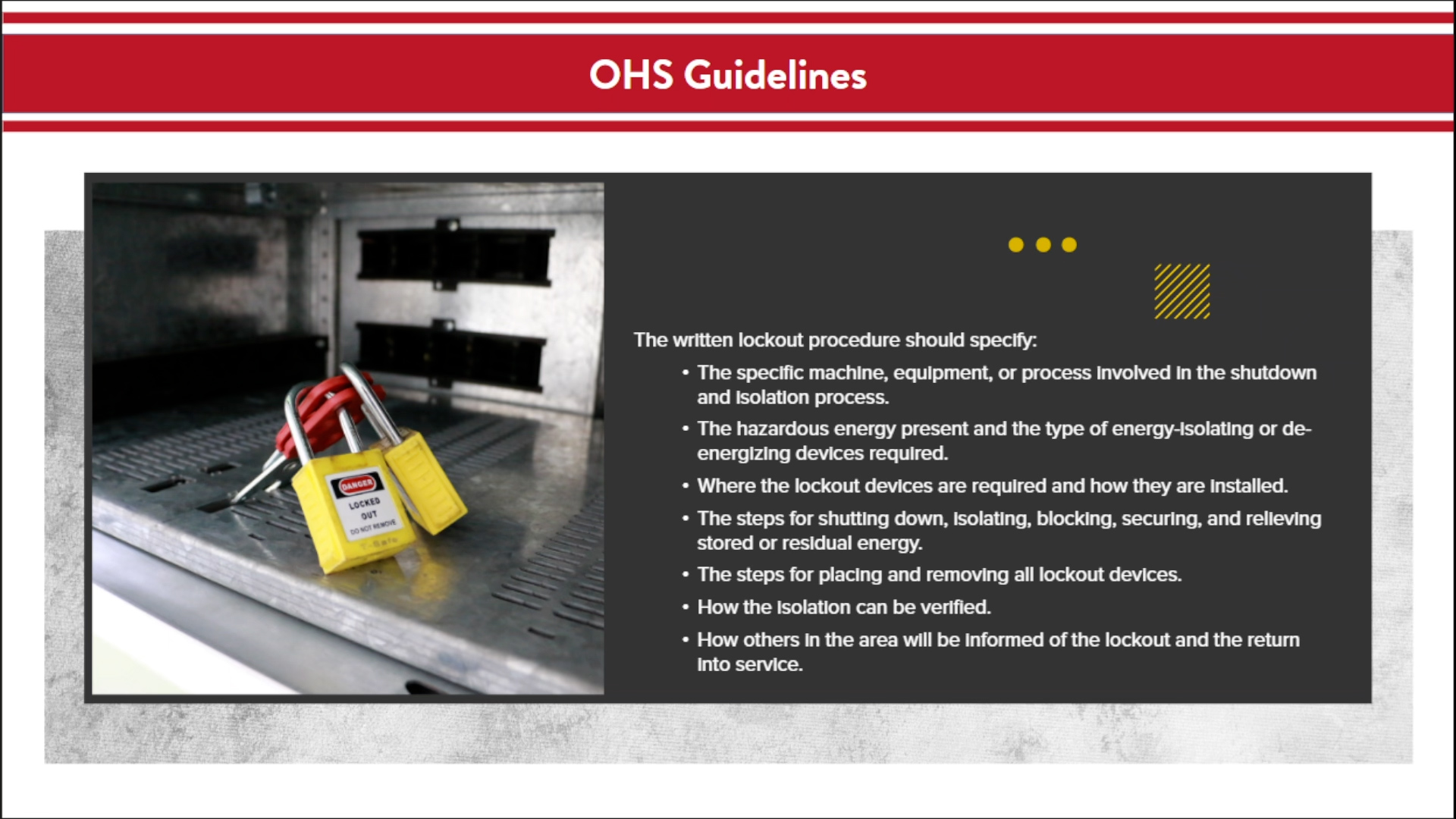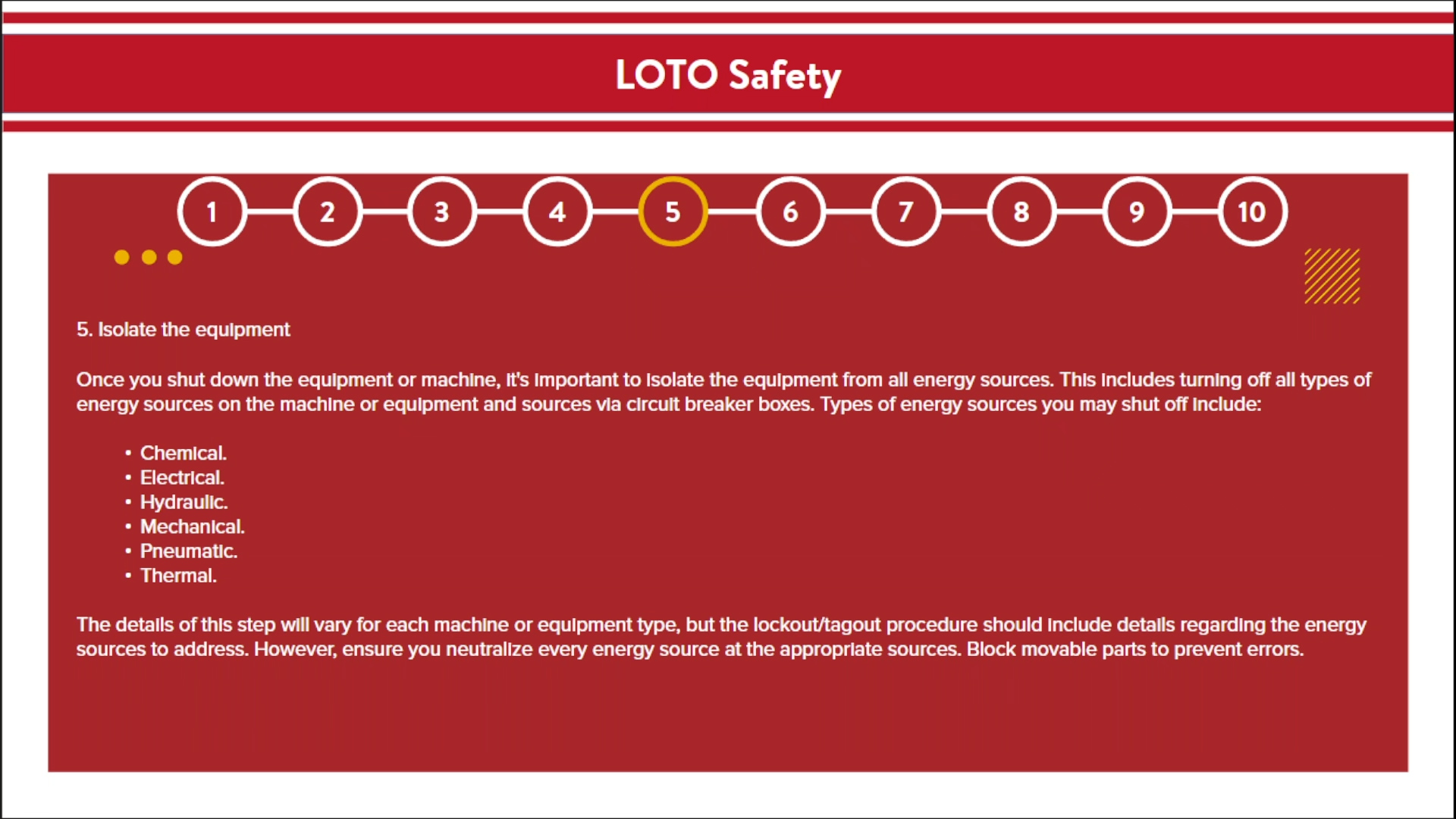Workers injured on the job from exposure to hazardous energy lose an average of 24 workdays for recuperation. This course covers the purpose of LOTO, locks and tags and their use, and the differences between authorized, affected and other employees.
Lock Out Tag Out (LOTO)
Original price was: $11.99.$9.99Current price is: $9.99.
Description
In any form, energy becomes hazardous when it builds to a certain level, or is released inadvertently or unexpectedly. The phrase, lockout/tag out, refers to specific practices and procedures that safeguard employees from the unexpected startup of machinery and equipment, or the release of hazardous energy, during service or maintenance activities.
Locks and Tags Purpose
Lock and tag procedures establish safe boundaries to protect workers, in addition to ensuring that a machine has been isolated or disconnected from its power source. Individually, locks and tags serve different purposes and must be used accordingly.
Tags alone cannot sufficiently prevent an individual from starting a piece of equipment while another individual is servicing it. Due to this fact, tags must only act as temporary warnings until the hazardous equipment can be properly locked.
Every tag needs to be securely attached, legible and understandable. As well, tags must be made of materials capable of withstanding the environmental conditions they may encounter, such as rain or snow, and they must bear the name of the authorized person placing the tag on the equipment. Whenever possible, fasten tags to the same point as the lock. If that is not possible, then the tag must be near the lock and immediately obvious.
Locks are barriers keeping equipment from starting up and causing harm to someone who may be working on that piece of machinery. In order to work, locks must hold the energy isolating devices in a “safe” or “off” position. Regularly, locks should be inspected to guarantee they are standardized and durable.
Every lock needs to be keyed differently so no more than one person’s key will open it. Whenever a combination lock is used, for everyone’s safety only the person placing the lock can know the combination to open it. There’s a reason for placing locks and tags on equipment, therefore they should never be ignored or removed by anyone other than the individual who placed them.
In the case that it is not possible to lock a de-energized energy source, only a tag may be used. Any tag without a lock should be treated as if it is a lock. Whoever placed the tag must be identified on it, typically through the person’s name and contact information.
Lock and Tag Training
Standards require employers train workers so that they can understand the purpose and function of an energy control program, in addition to its lockout and tag out procedures.
An authorized employee is someone who received training in recognizing applicable hazardous energy sources, type and magnitude of the energy available, and methods and means for energy isolation and control. As well, these employees must be annually trained on the control of hazardous energy, and must be retrained when there is a change in job assignments, machines, or energy control procedures.
It is crucial that authorized employees are the only people allowed to apply locks or tags and perform work on isolated equipment. Before starting work, the authorized employee is responsible for verifying that the equipment is isolated and de-energized. In addition, they must perform annual inspections to ensure energy control procedures are being followed. In the case that there are deviations in equipment, or inadequacies in the use and knowledge of energy control procedures are identified, the issue must be corrected immediately through repairs, new equipment purchases, or employee retraining.
On the other hand, an affected employee is someone who, during normal operations, uses a machine or equipment on which servicing or maintenance will be performed under a lockout/tag out action, or works in an area in which such servicing or maintenance is being performed.
Everyone else is those who work operations require them to access but not operate machinery in an area where energy control procedures may be utilized. These may be other employees, visitors, or contractors who are working in the area.
For both the health and safety of workers, lock and tag procedures are vital. Employers must follow OSHA’s standard for the Control of Hazardous Energy to protect their employees from harm.
Here are three basic rules related to the lockout/tag out standard:
- Employees who aren’t qualified should never remove a lock or tag, or operate a piece of equipment that is locked or tagged.
- Locks that isolate energy sources are required to be dedicated, marked, and not used for any other purpose.
- The tags in lockout/tag out activities are colored red, to communicate ‘danger’. As well, they may include different warnings printed on them, such as ‘Do Not Operate’, ‘Do Not Start’, ‘Do Not Open’, ‘Do Not Close’, or ‘Do Not Energize’. Only ever use locks and tags that are constructed to withstand the environment in which they are used.
Worker Responsibilities for Locks and Tags
- Be conscious of and follow lockout/tag out procedures.
- Do not remove a lock or tag.
- Do not try to restart, or restore energy to, a machine, circuit, or any equipment that is locked or tagged.
- Do not try to bypass equipment that is locked or tagged.
- All lockout/tag out training is crucial to the safety of employees working with electrical equipment. Prior to conducting lockout/tag out procedures, make sure that machines and equipment are stopped, isolated from all potentially hazardous energy sources, and locked out before employees perform any servicing or maintenance.
Employees can conduct some routine tasks and maintenance without invoking lock and tag procedures. However, employers need to first confirm that tasks for exception are routine, repetitive, and integral to normal production, document excepted tasks in the company’s lock and tag policy, and train workers on ways to conduct tasks safely.
Why SafetyNow?
Not all training is equal. With SafetyNow, learners and leaders will notice the difference in value:
- Quality: Professionally-researched and designed using the latest mobile and responsive technologies
- Convenience: Works instantly on any device, desktop or mobile
- Time savings: What learners need to know, not extra fluff or legalese
- Reporting: Consistent, instant compliance records available anytime
- Support: Customer and learner support included at no charge
- Understanding the purpose of lock and tag procedures
- Connecting the roles and responsibilities for worker designations under lock and tag
- Recognizing the sources of energy hazards and consequences of improper control
- Acknowledging employer responsibilities and requirements for lock and tag
- Identifying different types of lock and tag devices
- Learning the basic procedural steps for lock and tag
- Comprehending criteria and situations that qualify as exceptions to lock and tag requirements
- Any Learning Management System (LMS) Use with any SCORM, AICC, xAPI, TinCan, HTML5, or other LMS (learning management system).
- Any Device Desktop, laptop, tablet, or mobile phone – it simply works, everywhere.
- Engaging Professionally-developed, including an on-screen host and modern, easy-to-understand text, media, and voiceovers.
- Unlimited Attempts Each module can be taken as many times as required to get a passing grade. Unlike our competitor’s courses, if you get an answer wrong, you are redirected to the exact eLearning segment you struggled with… you don’t need to go through the entire module again, just the one part you need a refresher on.
Only logged in customers who have purchased this product may leave a review.














Reviews
There are no reviews yet.